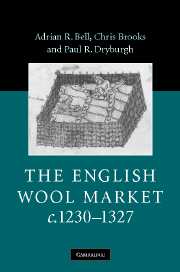Book contents
- Frontmatter
- Contents
- Acknowledgements
- Notes on weights, measures and monetary units
- Glossary of wool terms
- 1 Introduction
- 2 Advance contracts for the sale of wool
- 3 Case study – Pipewell Abbey, Northamptonshire
- 4 Modern finance in the Middle Ages
- 5 Conclusions
- Appendix 1 Sample contract
- Appendix 2 Summary facts and figures of contracts
- Appendix 3 List of contracts
- Bibliography
- Index
1 - Introduction
Published online by Cambridge University Press: 28 July 2009
- Frontmatter
- Contents
- Acknowledgements
- Notes on weights, measures and monetary units
- Glossary of wool terms
- 1 Introduction
- 2 Advance contracts for the sale of wool
- 3 Case study – Pipewell Abbey, Northamptonshire
- 4 Modern finance in the Middle Ages
- 5 Conclusions
- Appendix 1 Sample contract
- Appendix 2 Summary facts and figures of contracts
- Appendix 3 List of contracts
- Bibliography
- Index
Summary
THE CONTEXT
[T]he Wolles growyyn withynne this Reaume, here before have ben the great comodite, enrichyng and welfare of this land.
Petitioners to parliament in 1453, in making an impassioned plea over the depressed state of the wool market at that time, consciously harked back to an era when trade in wool had been the backbone and driving force in the English medieval economy. The period which had undoubtedly witnessed the greatest activity, indeed, was the fifty years either side of the turn of the fourteenth century, when the interplay of warfare, governmental interference in the form of taxes, export duties and export bans, epidemics of disease and famine, better marketing practices, and serious competition among some of the most important elements of the European mercantile elite for the superior product of the English wool-grower, created an unparalleled cycle of boom and bust in wool exports and prices.
It should occasion no surprise, therefore, that it is the wool trade of the late thirteenth and early fourteenth centuries that has predominantly attracted the attention of modern scholars. This is particularly the case when the ample volume and rich variety of surviving source material for this period, notably including extensive, if not comprehensive customs accounts, and schedules and treatises of prices and producers, is taken into consideration. Chief amongst these is the raft of contracts for the advance purchase of wool entered into by both monastic institutions and lay producers, who bargained for the sale of the produce of their flocks for up to twenty years in advance with mostly foreign and particularly Italian (more specifically Florentine and Lucchese) merchant societies often in return for huge sums of liquid capital.
- Type
- Chapter
- Information
- The English Wool Market, c.1230–1327 , pp. 1 - 10Publisher: Cambridge University PressPrint publication year: 2007



